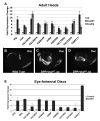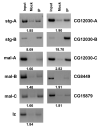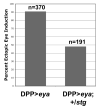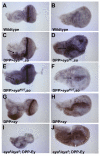Identification of transcriptional targets of the dual-function transcription factor/phosphatase eyes absent
- PMID: 17714699
- PMCID: PMC2075104
- DOI: 10.1016/j.ydbio.2007.07.024
Identification of transcriptional targets of the dual-function transcription factor/phosphatase eyes absent
Abstract
Drosophila eye specification and development relies on a collection of transcription factors termed the retinal determination gene network (RDGN). Two members of this network, Eyes absent (EYA) and Sine oculis (SO), form a transcriptional complex in which EYA provides the transactivation function while SO provides the DNA binding activity. EYA also functions as a protein tyrosine phosphatase, raising the question of whether transcriptional output is dependent or independent of phosphatase activity. To explore this, we used microarrays together with binding site analysis, quantitative real-time PCR, chromatin immunoprecipitation, genetics and in vivo expression analysis to identify new EYA-SO targets. In parallel, we examined the expression profiles of tissue expressing phosphatase mutant eya and found that reducing phosphatase activity did not globally impair transcriptional output. Among the targets identified by our analysis was the cell cycle regulatory gene, string (stg), suggesting that EYA and SO may influence cell proliferation through transcriptional regulation of stg. Future investigation into the regulation of stg and other EYA-SO targets identified in this study will help elucidate the transcriptional circuitries whereby output from the RDGN integrates with other signaling inputs to coordinate retinal development.
Figures






References
-
- Abdelhak S, Kalatzis V, Heilig R, Compain S, Samson D, Vincent C, Weil D, Cruaud C, Sahly I, Leibovici M, Bitner-Glindzicz M, Francis M, Lacombe D, Vigneron J, Charachon R, Boven K, Bedbeder P, Van Regemorter N, Weissenbach J, Petit C. A human homologue of the Drosophila eyes absent gene underlies branchio-oto-renal (BOR) syndrome and identifies a novel gene family. Nat Genet. 1997;15:157–64. - PubMed
-
- Abramoff MD, Magelhaes PJ, Ram SJ. Image Processing with ImageJ. Biophotonics International. 2004;11:36–42.
-
- Aligianis IA, Johnson CA, Gissen P, Chen D, Hampshire D, Hoffmann K, Maina EN, Morgan NV, Tee L, Morton J, Ainsworth JR, Horn D, Rosser E, Cole TR, Stolte-Dijkstra I, Fieggen K, Clayton-Smith J, Megarbane A, Shield JP, Newbury-Ecob R, Dobyns WB, Graham JM, Jr., Kjaer KW, Warburg M, Bond J, Trembath RC, Harris LW, Takai Y, Mundlos S, Tannahill D, Woods CG, Maher ER. Mutations of the catalytic subunit of RAB3GAP cause Warburg Micro syndrome. Nat Genet. 2005;37:221–3. - PubMed
-
- Alphey L, Jimenez J, White-Cooper H, Dawson I, Nurse P, Glover DM. twine, a cdc25 homolog that functions in the male and female germline of Drosophila. Cell. 1992;69:977–88. - PubMed
-
- Amrani L, Primus J, Glatigny A, Arcangeli L, Scazzocchio C, Finnerty V. Comparison of the sequences of the Aspergillus nidulans hxB and Drosophila melanogaster ma-l genes with nifS from Azotobacter vinelandii suggests a mechanism for the insertion of the terminal sulphur atom in the molybdopterin cofactor. Mol Microbiol. 2000;38:114–25. - PubMed
Publication types
MeSH terms
Substances
Grants and funding
LinkOut - more resources
Full Text Sources
Molecular Biology Databases

